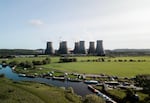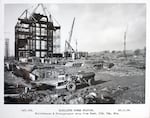
The Ratcliffe-on-Soar power plant in Nottinghamshire, England was the last operating coal-fired plant in the U.K.
Uniper
When the coal-fired turbines at this sprawling power plant north of London went silent this week, the skies above its eight giant steam stacks finally cleared – and Britain became the world’s first major economy to quit coal power.
It’s a milestone for the country that was first to harness the dirty fuel, in the 19th century. Coal powered the Industrial Revolution and the expansion of the British Empire. At the height of its reliance on coal, in the 1950s, about 96% of the United Kingdom’s electricity came from burning it.
That fell to zero Monday evening, when the Ratcliffe-on-Soar power plant, in the English Midlands, shut off its turbines after 57 years. It was the country’s last coal-fired plant.
“This is the first time in 142 years that there’s no coal in the U.K. electricity system,” says Michael Lewis, CEO of Uniper, the German company that runs the plant. “It’s a big, big moment in industrial history. That history can continue with zero carbon.”
It’s also a milestone in the effort to tackle climate change. Burning coal releases carbon dioxide, and is a major driver of global warming. A handful of smaller countries have already phased out coal power, but Britain is first among the Group of Seven advanced economies to do so. The entire G7 has pledged to follow suit by 2035.
The U.K. has turned to cheaper and cleaner power sources, including natural gas but also a major expansion of offshore wind and solar farms. Meanwhile, regulations targeting air pollution and greenhouse gas emissions have made burning coal increasingly uneconomical.
In its heyday, Ratcliffe-on-Soar received more than 20 trainloads of coal per day, according to Uniper. That’s enough to power two million homes. (Or in British terms, a billion cups of tea a day.)
Decommissioning will take two years; most of the plant’s 170 employees are being reallocated. There were a few tears, Lewis said. The longest-serving employee had worked at the plant for nearly 50 years.
“We need to get off coal. We need to address climate change targets,” Lewis told NPR. “But at the same time, it’s the end of an era.”
Coal made modern Britain
The Romans found coal in western England as early as the third century, according to the British Geological Survey. Mining began in earnest in the 1600s across England, Scotland and Wales.
Around the turn of the 18th century, the coal-powered steam engine was invented in Britain, going on to power industry. In the early 19th century, a British engineer invented the coal-fired locomotive, speeding commerce across the country and its colonies in South Asia and Africa.

Construction of the Ratcliffe-on-Soar power station in 1964.
Uniper
Then in 1882, Thomas Edison’s company opened Britain’s first coal-fired power plant in London.
Since then, British coal plants have burned 5 billion tons of coal, emitting more than 11 billion tons of carbon dioxide. That’s according to an analysis by the British publication Carbon Brief, which says the U.K.’s long coal habit produced more carbon emissions than most countries have ever produced from all sources – making it one of the largest historical contributors to climate change.
Those emissions typically stay in the atmosphere for decades or centuries.
By the 1950s, British coal use peaked, and so did pollution. Cities were shrouded in “pea soup” – a green toxic haze that included soot and sulfur dioxide from factory furnaces and residential coal fireplaces. The word “smog” was coined in London.
In the so-called Great Smog of 1952, at least 4,000 people died in the span of four days. It was so toxic, cows were said to have choked to death in fields.
That health emergency ultimately changed the economics of coal.
“In the 1950s, when the smog was killing thousands of people in London, the clean air laws came in, and then from the 1990s, relatively cleaner and cheaper gas began edging coal out,” says Sepi Golzari-Munro, a Scotland-based climate and energy analyst. “Now we see that transition happening again, with renewables.”
How did the UK manage this energy milestone?
In part, Britain got lucky: In the 1960s, it discovered natural gas – a cheaper, relatively cleaner-burning fuel – in the North Sea. Last year, about a third of U.K. electricity came from gas.
In recent decades, the U.K. has also invested in a massive expansion of renewable energy, especially offshore wind. Britain is now the world’s second-largest offshore wind market, after China. Last year, offshore wind generated 17% of the nation’s electricity, according to the Crown Estate, which manages wind farms on royal land.
“We were able to take the onshore wind industry and move it offshore, where you get much higher wind speeds, and you can put in bigger turbines, and bigger wind farms,” says Bryony Worthington, an environmental campaigner now in the House of Lords. Worthington helped write the country’s Climate Change Act of 2008, which set national targets for the reduction of carbon emissions.
Britain also operates five nuclear power plants. The government plans to quadruple nuclear capacity by 2050.

A truck hauls coal outside the Ratcliffe-on-Soar power station in Nottinghamshire, England
Uniper
Unlike the United States, where a number of lawmakers question the scientific consensus that human activity is driving global warming, there’s widespread, cross-party consensus in the U.K. in favor of this clean energy transition, and environmental regulation.
“In the early 2000s, we were writing the world’s first set of comprehensive laws on climate change that created legally binding carbon budgets,” Worthington recalls. Those laws limited how much particulate matter coal stations could emit, banned new coal stations from being built, and taxed coal plants for their pollution, she notes.
Looking ahead, the government aims to eliminate natural gas from the U.K. power grid by 2030, and cut carbon emissions entirely by 2050.
Altogether, these laws and taxes mean it’s no longer economical to mine British coal, or burn it. In 2015, lawmakers identified the last day of coal power a decade in advance, and then moved it up by a year – a relatively rapid phaseout that could be a model for other countries.
End of an era
This energy transition has been aided by globalization and deindustrialization. Since the 1970s, the U.K has moved away from manufacturing, to a service economy. This country no longer runs as many big factories.
On Monday night, at a pub not far from the Ratcliffe-on-Soar smoke stacks, former workers raised a pint to the past. But the nostalgia only goes so far.

A train delivers coal by night at the Ratcliffe-on-Soar power station in Nottinghamshire, England. In its heyday, the plant received more than 20 truckloads of coal per day.
Uniper
“It’s good it’s closing down, because of all the rubbish that was coming out into the atmosphere,” says 71-year-old Simon Humble. “When I worked there, even after a shower, you’d sneeze and all the coal dust was coming out of your nose.”
He says he’s looking forward to seeing the plant’s eight giant cooling towers demolished.
“I imagine they’ll dynamite them down to the ground,” he says. “Now that’ll be something to see.”